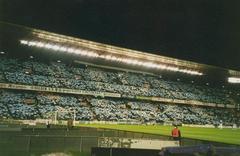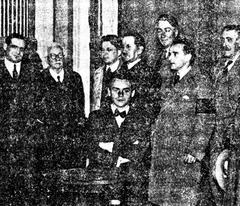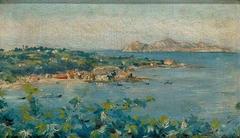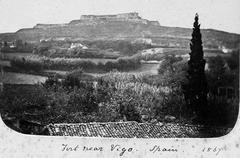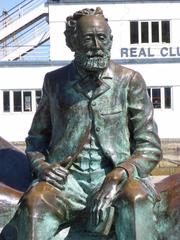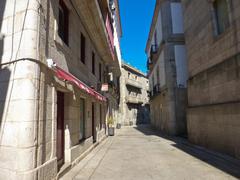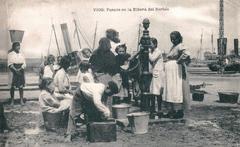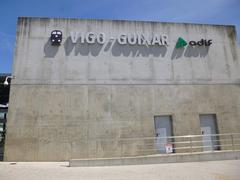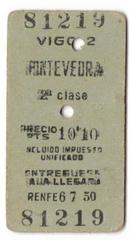
Panificadora de Vigo: Visiting Hours, Tickets, and Historical Site Guide
Date: 04/07/2025
Introduction: Discovering the Panificadora de Vigo
The Panificadora de Vigo stands as a monumental symbol of the city’s industrial heritage, architectural ingenuity, and socio-economic transformation. Situated in the Falperra neighborhood, this early 20th-century former bakery factory was instrumental in modernizing bread production and distribution in Vigo and the surrounding region. Its unique reinforced concrete silos and rationalist design, created by Manuel Gómez Román with German engineering support, have become iconic features of the city’s skyline. Although the factory ceased operations in 1980 and experienced periods of neglect and vandalism, it remains a landmark under active preservation, with ambitious rehabilitation plans set to revitalize its role in Vigo’s urban fabric.
While interior access is currently restricted due to ongoing restoration, the Panificadora’s exterior offers panoramic views and photographic opportunities. The site’s proximity to other historic and cultural attractions, such as Casco Vello and the Castro Fortress, makes it a key destination for visitors interested in Vigo’s past and future.
This guide provides essential information on visiting the Panificadora de Vigo, including current access conditions, ticketing, accessibility, historical context, architectural features, travel tips, and the latest updates on rehabilitation efforts. For up-to-date details, consult official resources such as the DoCoMoMo Ibérico, Official Vigo Tourism Website, and Hispania Nostra.
Contents
- Introduction and Overview
- Visitor Information (Hours, Tickets, Accessibility)
- Getting There and Travel Tips
- Historical Overview
- Origins and Foundation
- Expansion and Architectural Innovation
- Social and Economic Impact
- Decline and Abandonment
- Heritage Status and Rehabilitation
- Architectural Features
- Site Layout
- Reinforced Concrete and Silos
- Main Buildings and Technical Innovations
- Nearby Attractions
- Community Engagement and Future Vision
- Panificadora Rehabilitation: Timeline and Phases
- Frequently Asked Questions (FAQ)
- Visual Media and Maps
- Conclusion and Visitor Recommendations
- Sources and Further Reading
Visitor Information: Hours, Tickets, and Accessibility
Current Status:
The Panificadora de Vigo is not open for regular interior visits due to restoration and safety concerns. There are no standard visiting hours or ticket sales at this time. Occasionally, the city council and heritage groups organize special guided tours or cultural events, which are announced via official tourism channels.
Exterior Viewing:
The site’s exterior and surrounding streets can be visited at any time, offering excellent vantage points for photography and appreciation of the industrial architecture.
Accessibility:
Due to uneven terrain and ongoing works, accessibility for those with mobility challenges is limited. When restoration is complete, accessibility will be a priority, with plans for wheelchair-friendly pathways and facilities.
Stay Updated:
For announcements about guided tours, events, or reopening dates, regularly consult the Official Vigo Tourism Website and DoCoMoMo Ibérico.
Getting There and Travel Tips
- Location: Falperra neighborhood, central Vigo, near Praza do Rei and Casco Vello.
- Public Transport: Easily accessible by local bus lines or taxi from the city center.
- By Foot: The site is within walking distance from key downtown locations.
- Parking: Limited in the immediate area; public parking is available nearby.
- Travel Tips: Wear comfortable shoes to navigate uneven ground. Consider combining your visit with nearby attractions for a full day of exploration.
Historical Overview
Origins and Foundation
The Panificadora de Vigo was established in 1920 by Antonio Valcarce García and four prominent local bakers to modernize bread production for the growing city. Designed by architect Manuel Gómez Román with German engineering contributions from Werner und Pfleiderer, it incorporated advanced baking technology and introduced reinforced concrete construction to industrial architecture in Spain.
Expansion and Architectural Innovation
Opened in 1924, the factory blended functional industrial design with Galician influences. Major expansions in the 1930s added a milling section and the now-iconic reinforced concrete silos, which define the city’s skyline. The complex eventually occupied over 7,200 square meters, including production halls, workshops, employee residences, and technical innovations such as a floodable warehouse roof for thermal regulation.
Social and Economic Impact
Throughout the mid-20th century, the Panificadora was the largest bakery in Vigo and a major regional employer. It played a vital role in food security, urban growth, and technological advancement, expanding distribution to areas such as Salamanca and Ávila.
Decline and Abandonment
Despite diversification efforts in the 1960s, the factory ceased operations in 1980 after the founder’s death. The site subsequently suffered neglect, vandalism, and multiple fires, with several unrealized real estate redevelopment proposals.
Heritage Status and Rehabilitation
Public campaigns eventually led to the Panificadora’s recognition as a culturally significant site. Since 2011, increased efforts have focused on conservation and adaptive reuse. In 2012, it was declared a Bien de Interés Cultural (BIC), reinforcing its protected status and laying the groundwork for the current rehabilitation project.
Architectural Features
Site Layout and Urban Context
Occupying a sloped urban plot, the Panificadora integrates multiple interconnected buildings, including the main production hall, silos, warehouses, and auxiliary structures. The design harmonizes with the natural topography, transitioning from residential to industrial zones.
Reinforced Concrete and Silos
Among the first Spanish factories to employ reinforced concrete extensively, the Panificadora’s structures—especially the silos—remain largely intact. The silos, constructed in two phases (four cylindrical pre-1931 and six oval pre-1940), create a striking visual rhythm in the cityscape.
Main Buildings and Technical Innovations
The main building, designed by Gómez Román and engineer Otto Werner, features rationalist, open-plan interiors, large windows, and restrained décor. Technical innovations include a floodable roof for thermal control, in-house power generation, a gasoline station, and workshops for self-sufficiency. Materials such as concrete, steel, wood, and brick were selected for durability, fire resistance, and aesthetic value.
Nearby Attractions
Complement your visit with these notable sites:
- Castro Fortress: Historic hilltop fortification with panoramic city and bay views.
- Casco Vello (Old Town): Vibrant district of narrow lanes, shops, and traditional Galician cuisine.
- Islas Cíes: Renowned for pristine beaches and hiking trails, accessible by ferry.
- Praza do Rei: Central square adjacent to the Panificadora, often hosting cultural events.
Community Engagement and Future Vision
Community groups, such as the Asociación Cultural do Barrio Alto do Casco Vello, have been instrumental in advocating for a revitalization that balances cultural, residential, and economic uses. Proposals from 2016 onward envision a multifunctional urban hub with affordable housing, artisan workshops, shared gardens, and cultural venues—including galleries and a panoramic restaurant atop the silos.
The rehabilitation is designed to foster social integration, support creative industries, and celebrate Vigo’s culinary and artistic traditions, drawing inspiration from successful models like Madrid’s Mercado de San Antón.
Panificadora Rehabilitation: Timeline and Project Phases
- Expropriation Project Drafting: Early 2025, duration 10–12 months.
- Legal Consolidation and Expropriation: Post-drafting, to unify property ownership.
- Tendering Rehabilitation Work: First half of 2025, encompassing architectural and engineering planning.
- Construction and Urban Integration: Focused on restoring heritage features and enhancing connections with Praza do Rei, Casco Vello, and Paseo de Alfonso.
Current agreements between the Concello de Vigo and Zona Franca de Vigo set the stage for a comprehensive, publicly funded transformation.
Frequently Asked Questions (FAQ)
Q: Can I visit the Panificadora de Vigo now?
A: Only the exterior and surrounding streets are accessible due to restoration work. Guided tours may be available during special events—check official sources.
Q: Is there an entrance fee?
A: No regular ticketing exists at present. Future ticketing for exhibitions or guided tours will be announced closer to reopening.
Q: Is the site accessible for visitors with disabilities?
A: Accessibility is limited during restoration. The completed project will include accessible pathways and facilities.
Q: How can I reach the Panificadora?
A: It is centrally located in Falperra, near Praza do Rei, accessible on foot, by public transport, or by taxi.
Q: Are guided tours available?
A: These are offered occasionally for special events; check Official Vigo Tourism Website for updates.
Visual Media and Maps
High-quality images and virtual tours are available through official heritage websites (DoCoMoMo Ibérico) and the city’s tourism portal. Recommended alt text for images:
- “Panificadora de Vigo concrete silos against a blue sky”
- “Panoramic view of Ría de Vigo from Panificadora site”
- “Restoration works at Panificadora de Vigo”
Interactive maps highlight the Panificadora’s location and nearby attractions.
Conclusion and Visitor Recommendations
The Panificadora de Vigo epitomizes Vigo’s journey from industrial powerhouse to modern urban center, blending architectural innovation with deep social roots. While regular public access is currently restricted, ongoing rehabilitation efforts promise to restore the Panificadora as a dynamic cultural and community landmark.
Visitor Tips:
- Enjoy the exterior architecture and city views from nearby streets while restoration is underway.
- Combine your visit with local attractions for a well-rounded Vigo experience.
- Stay updated on reopening and event announcements via DoCoMoMo Ibérico, Official Vigo Tourism Website, and digital platforms like the Audiala app.
By engaging with this emblematic site and supporting preservation initiatives, you contribute to the living narrative of Vigo’s cultural heritage.
Official Sources and Further Reading
- Panificadora de Vigo: Visiting Hours, Tickets, and Historical Guide to Vigo’s Industrial Landmark
- Visiting Panificadora de Vigo: Architectural Highlights, History, and Visitor Information
- La Panificadora Vigo Visiting Hours, History & Guide to This Iconic Vigo Historical Site
- Panificadora de Vigo Rehabilitation: Visiting Hours, Tickets, and Historical Insights
- Faro de Vigo article on La Panificadora rehabilitation
- Asociación Cultural do Barrio Alto do Casco Vello

